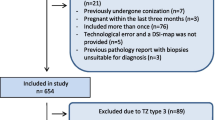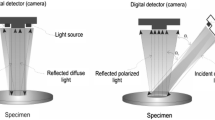Abstract
Cervical cancer is one of the most common and lethal gynecological malignancies in both developing and developed countries, and therefore, there is a considerable interest in early diagnosis and treatment of precancerous lesions. Although the current standard care mainly based on cytology and colposcopy has reduced rates of cervical cancer morbidity and mortality, many lesions are still missed or overcalled and referred for unnecessary biopsies. Optical imaging technologies, spectroscopy approaches and high-resolution imaging methods are anticipated to improve the conventional cervical cancer screening providing in vivo diagnosis with high sensitivity and specificity. Their concept is that morphologic and biochemical properties of the cervical tissue are altered in response to its malignant transformation. In addition, contrast agents that target against specific neoplastic biomarkers can enhance the effectiveness of this new technology. Due to the unprecedented growth of these optical techniques accompanied probably by favorable cost-effectiveness, the primary detection of premalignant lesions may become more accessible in both the developing and the developed countries and can offer see-to-treat workflows and early therapeutic interventions.



Similar content being viewed by others
References
Parkin DM, Bray F, Ferlay J, Pisani P (2002) Global cancer statistics. CA Cancer J Clin 55:74–108
Agosti JM, Goldie SJ (2007) Introducing HPV vaccine in developing countries–key challenges and issues. N Engl J Med 356:1908–1910
National Cancer Institute (NCI). Cervical Cancer Screening (PDQ®). Last Modified: 07/03/2010. http://www.cancer.gov/cancertopics/pdq/screening/cervical/healthprofessional
Mitchell MF, Schottenfeld D, Tortolero-Luna G, Cantor SB, Richards-Kortum R (1998) Colposcopy for the diagnosis of squamous intraepithelial lesions: a meta-analysis. Obstet Gynecol 91:626–631
Sawaya GF, Brown AD, Washington AE, Garber AM (2001) Clinical practice. Current approaches to cervical-cancer screening. N Engl J Med 344:1603–1607
Sauvaget C, Fayette JM, Muwonge R, Wesley R, Sankaranarayanan R (2011) Accuracy of visual inspection with acetic acid for cervical cancer screening. Int J Gynaecol Obstet 113:14–24
Anonymous. Electro-optical sensors for the in vivo detection of cervical cancer and its precursors: submission guidance for an IDE/PMA. Rockville, MD. Food and drug administration. 1999 05/21/1999:Report No:266
Thekket N, Richards-Kortum R (2008) Optical imaging for cervical cancer detection: solutions for a continuing global problem. Nat Rev Cancer 8:725–731
Mourant JR, Canpolat M, Brocker C et al (2000) Light scattering from cells: the contribution of the nucleus and the effects of proliferative status. J Biomed Opt 5:131–137
Collier T, Follen M, Malpica A, Richards-Kortum R (2005) Sources of scattering in cervical tissue: determination of the scattering coefficient by confocal microscopy. Appl Opt 44:2072–2081
Drezek R, Guillaud M, Collier T et al (2003) Light scattering from cervical cells throughout neoplastic progression: influence of nuclear morphology, DNA content, and chromatin texture. J Biomed 8:7–16
Drezek R, Brookner C, Pavlova I et al (2001) Autofluorescence microscopy of fresh cervical-tissue sections reveals alterations in tissue biochemistry with dysplasia. Photochem Photobiol 73:636–641
Adrian Freeberg J, Benedet JL, West LA, Atkinson EN, MacAulay C, Follen M (2007) The clinical effectiveness of fluorescence and reflectance spectroscopy for the in vivo diagnosis of cervical neoplasia: An analysis by phase of trial design. Gynecol Oncol 107:270–280
Mourant JR, Bocklage TJ, Powers TM et al (2007) In vivo light scattering measurements for detection of precancerous conditions of the cervix. Gynecol Oncol 105:439–445
Chang SK, Mirabal YN, Atkinson EN et al (2005) Combined reflectance and fluorescence spectroscopy for in vivo detection of cervical pre-cancer. J Biomed Opt 10:024031
Georgakoudi I, Sheets EE, Muller MG et al (2002) Trimodal spectroscopy for the detection and characterization of cervical precancers in vivo. Am J Obstet Gynecol 186:374–382
Nordstrom RJ, Burke L, Niloff JM, Myrtle JF (2001) Identification of cervical intraepithelial neoplasia (CIN) using UV-excited fluorescence and diffuse-reflectance tissue spectroscopy. Lasers Surg Med 29:118–127
Parker MF, Mooradian GC, Okimoto GS, O’ Connor DM, Miyazawa K, Saggese SJ (2002) Initial neural net construction for the detection of cervical intraepithelial neoplasia by fluorescence imaging. Am J Obstet Gynecol 187:398–402
Wright T, Ferenczy A, Wray S, Christinson R, Ganguly D (1999) Detection of cervical squamous intraepithelial lesions using evoked tissue fluorescence. Abstracts presented for the thirtieth annual meeting of the Society of gynecologic oncologists. Gynecol Oncol 72:45
Weingandt H, Stepp H, Baumgartner R, Diebold J, Xiang W, Hillemanns P (2002) Autofluorescence spectroscopy for the diagnosis of cervical intraepithelial neoplasia. Br J Obstet Gynecol 109:947–951
Chang SK, Follen M, Malpica A et al (2002) Optimal excitation wavelengths for discrimination of cervical neoplasia. IEEE Trans Biomed Eng 49:1102–1111
Mitchell MF, Cantor SB, Ramanujam N, Tortolero-Luna G, Richards-Kortum R (1999) Fluorescence spectroscopy for diagnosis of squamous intraepithelial lesions of the cervix. Obstet Gynecol 93:462–470
Mirabal YN, Chang SK, Atkinson EN, Malpica A, Follen M, Richards-Kortum R (2002) Reflectance spectroscopy for in vivo detection of cervical precancer. J Biomed Opt 7:587–594
Steller W, Einenkel J, Horn LC et al (2006) Delimitation of squamous cell cervical carcinoma using infrared microspectroscopic imaging. Anal Bioanal Chem 384:145–154
Boydston-White S, Romeo M, Chernenko T, Regina A, Miljkoviζ M, Diem M (2006) Cell-cycle-dependent variations in FTIR micro-spectra of single proliferating HeLa cells: principal component and artificial neural network analysis. Biochim Biophys Acta 1758:908–914
Podshyvalov A, Sahu RK, Mark S et al (2005) Distinction of cervical cancer biopsies by use of infrared microspectroscopy and probabilistic neural networks. Appl Opt 44:3334–3725
Krishna CM, Prathima NB, Malini R et al (2006) Raman spectroscopy studies for diagnosis of cancers in human Uterine cervix. Vib Spectrosc 41:136–141
Mo J, Zheng W, Low JJ, Ng J, Ilancheran A, Huang Z (2009) High wavenumber Raman spectroscopy for in vivo detection of cervical dysplasia. Anal Chem 81:8908–8915
Jess PRT, Smith DDW, Mazilu M, Dholakia K, Riches AC, Herrington CS (2007) Early detection of cervical neoplasia by Raman spectroscopy. Int J Cancer 121:2723–2728
Robichaux-Viehoever A, Kanter E, Shappell H, Billheimer D, Jones H, Mahadevan-Jansen A (2007) Characterization of Raman spectra measured in vivo for the detection of cervical dysplasia. Appl Spectrosc 61:986–993
Balas CJ, Themelis GC, Prokopakis EP, Orfanoudaki I, Koumantakis E, Helidonis ES (1999) In vivo detection and staging of epithelial dysplasias and malignancies based on the quantitative assessment of acetic acid-tissue interaction kinetics. J Photochem Photobiol B 53:153–157
Balas C (2001) A novel optical imaging method for the early detection, quantitative grading, and mapping of cancerous and precancerous lesions of cervix. IEEE Trans Biomed Eng 48:96–104
Orfanoudaki I, Themelis G, Sifakis S et al (2005) A clinical study of optical biopsy of the uterine cervix using a multispectral imaging system. Gynecol Oncol 96:119–131
Adrian Freeberg J, Benedet JL, MacAulay C, West LA, Follen M (2007) The performance of fluorescence and reflectance spectroscopy for the in vivo diagnosis of cervical neoplasia; point probe versus multispectral approaches. Gynecol Oncol 107:248–255
Ferris DG, Lawhead RA, Dickman ED et al (2001) Multimodal multispectral Imaging for the noninvasive diagnosis of cervical neoplasia. J Low Genit Tract Dis 5:65–72
DeSantis T, Chakhtoura N, Twiggs L et al (2007) Spectroscopic imaging as a triage test for cervical disease: a prospective multicenter clinical trial. J Low Genit Tract Dis 11:18–24
Huh WK, Cestero RM, Garcia FA et al (2004) Optical detection of high-grade cervical intraepithelial neoplasia in vivo: results of a 604-patient study. Am J Obstet Gynecol 190:1249–1257
Kendrick JE, Huh WK, Alvarez RD (2007) LUMA cervical imaging system. Expert Rev Med Devices 4:121–129
Alvarez RD, Wright TC (2007) Increased detection of high-grade cervical intraepithelial neoplasia utilizing an optical detection system as an adjunct to colposcopy. Gynecol Oncol 106:23–28
Alvarez RD, Wright TC (2007) Effective cervical neoplasia detection with a novel optical detection system: a randomized trial. Gynecol Oncol 104:281–289
Adams KE, Ke S, Kwon S et al (2007) Comparison of visible and near-infrared wavelength-excitable fluorescent dyes for molecular imaging of cancer. J Biomed Opt 12:024017
Aaron J, Nitin N, Travis K et al (2007) Plasmon resonance coupling of metal nanoparticles for molecular imaging of carcinogenesis in vivo. J Biomed Opt 12:034007
Chang E, Thekkek N, Yu WW, Colvin VL, Drezek R (2006) Evaluation of quantum dot cytotoxicity based on intracellular uptake. Small 2:1412–1417
Drezek R, Richards-Kortum R, Brewer MA et al (2003) Optical imaging of the cervix. Cancer 98:2015–2027
Tan J, Quinn M, Pyman J, Delaney P, McLaren W (2009) Detection of cervical intraepithelial neoplasia in vivo using confocal endomicroscopy. BJOG 116:1663–1670
Collier T, Lacy A, Richards-Kortum R, Malpica A, Follen M (2002) Near real-time confocal microscopy of amelanotic tissue: detection of dysplasia in ex vivo cervical tissue. Acad Radiol 9:504–512
Pitris C, Goodman A, Boppart SA, Libus JJ, Fujimoto JG, Brezinski ME (1999) High-resolution imaging of gynecologic neoplasms using optical coherence tomography. Obstet Gynecol 93:135–139
Huang D, Swanson EA, Lin CP et al (1991) Optical coherence tomography. Science 254(5035):1178–1181
Gallwas J, Turk L, Friese K, Dannecker C (2010) Optical coherence tomography as a non-invasive imaging technique for preinvasive and invasive neoplasia of the uterine cervix. Ultrasound Obstet Gynecol 36:624–629
Escobar PF, Belinson JL, White A et al (2004) Diagnostic efficacy of optical coherence tomography in the management of preinvasive and invasive cancer of uterine cervix and vulva. Int J Gynecol Cancer 14:470–474
Fujimoto JG, Pitris C, Boppart SA, Brezinski ME (2000) Optical coherence tomography: an emerging technology for biomedical imaging and optical biopsy. Neoplasia 2:9–25
Escobar PF, Rojas-Espaillat L, Tisci S et al (2006) Optical coherence tomography as a diagnostic aid to visual inspection and colposcopy for preinvasive and invasive cancer of the uterine cervix. Int J Gynecol Cancer 16:1815–1822
Wulan N, Rasool N, Belinson SE et al (2010) Study of the diagnostic efficacy of real-time optical coherence tomography as an adjunct to unaided visual inspection with acetic acid for the diagnosis of preinvasive and invasive neoplasia of the uterine cervix. Int J Gynecol Cancer 20:422–427
Barton JK, Guzman F, Tumlinson A (2004) Dual modality instrument for simultaneous optical coherence tomography imaging and fluorescence spectroscopy. J Biomed Opt 9:618–623
Lee SW, Yoo JY, Kang JH et al (2008) Optical diagnosis of cervical intraepithelial neoplasia (CIN) using polarization-sensitive optical coherence tomography. Optics Express 2709–2719
Liu Z, Belinson SE, Li J et al (2010) Diagnostic efficacy of real-time optical coherence tomography in the management of preinvasive and invasive neoplasia of the uterine cervix. Int J Gynecol Cancer 20:283–287
Conflict of interest
We declare that we have no conflict of interest.
Author information
Authors and Affiliations
Corresponding author
Rights and permissions
About this article
Cite this article
Orfanoudaki, I.M., Kappou, D. & Sifakis, S. Recent advances in optical imaging for cervical cancer detection. Arch Gynecol Obstet 284, 1197–1208 (2011). https://doi.org/10.1007/s00404-011-2009-4
Received:
Accepted:
Published:
Issue Date:
DOI: https://doi.org/10.1007/s00404-011-2009-4




